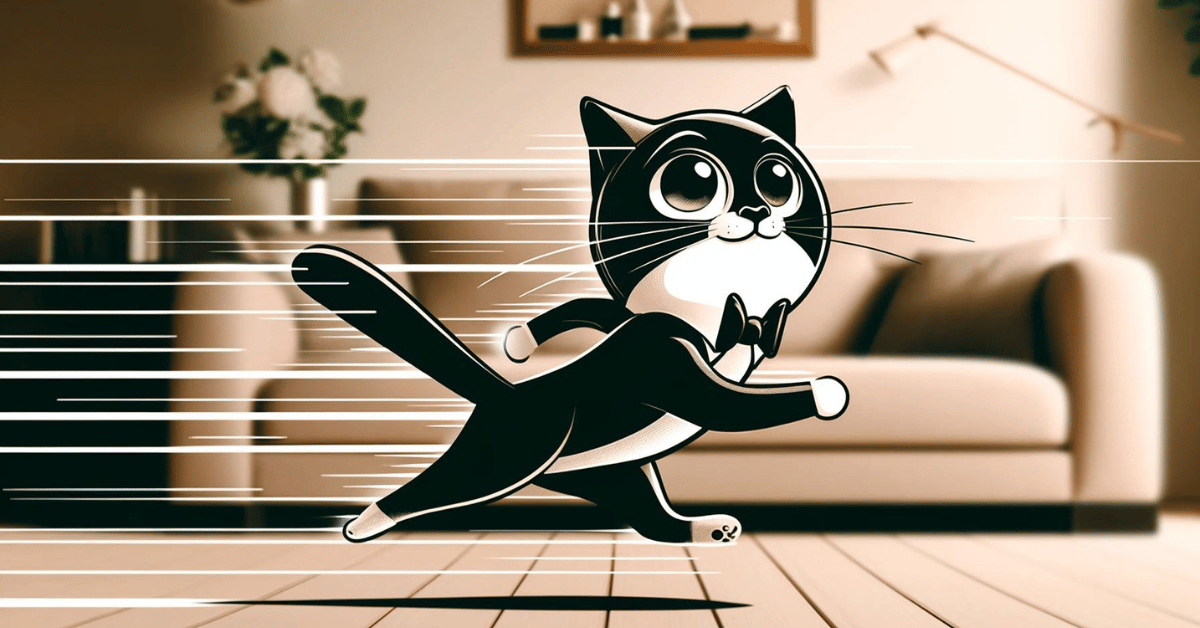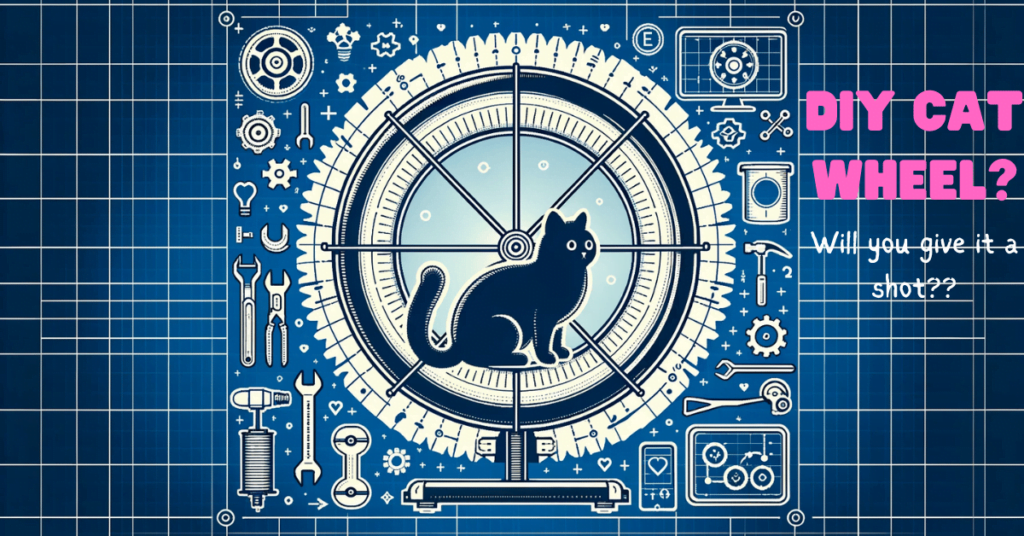This post contains affiliate links and I will be compensated if you make a purchase after clicking on my links.
Meet the Zoomies: Your Cat’s Wild Sprints Explained
Have you ever found yourself sitting peacefully when suddenly your cat bolts out of the room like a furry rocket, bouncing off the furniture with the wild abandon of a pinball? Welcome to the world of “cat zoomies,” or as the experts call them, Frenetic Random Activity Periods (FRAP).
These spontaneous bursts of energy can be both amusing and bewildering as they turn your quiet home into a feline racetrack.
What Are Cat Zoomies?
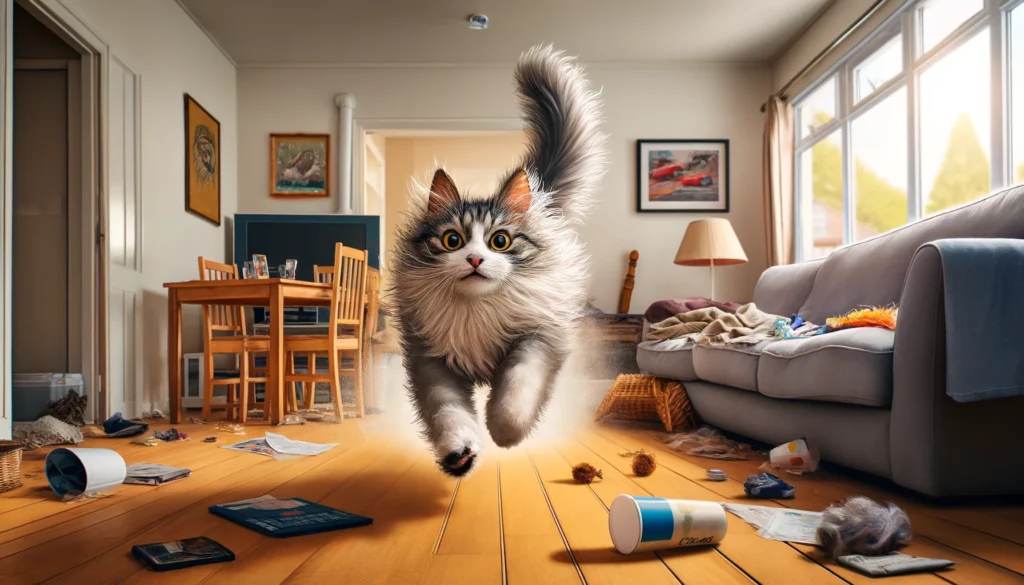
Cat zoomies are sudden, explosive bursts of activity where your cat may run around the house, darting back and forth, jumping on and off objects, or circling in tight loops with seemingly boundless energy. This behavior is typically spontaneous and can last anywhere from a few seconds to several minutes.
According to animal behaviorists, zoomies are a normal and healthy way for cats to expend their pent-up energy. In the wild, cats are predators who spend much of their time in a state of restful alertness, conserving energy for short bursts of intense activity needed during a hunt.
In a domestic setting, these energy bursts can seem random and without cause, but they serve a similar physiological purpose.
Unraveling the Mystery: Why Do Cats Get the Zoomies?
While the sudden and intense bursts of speed may seem whimsical or inexplicable, there is a fascinating array of reasons behind why cats get zoomies. Understanding these triggers can help cat owners better accommodate their pets’ natural behaviors and ensure a harmonious home environment.
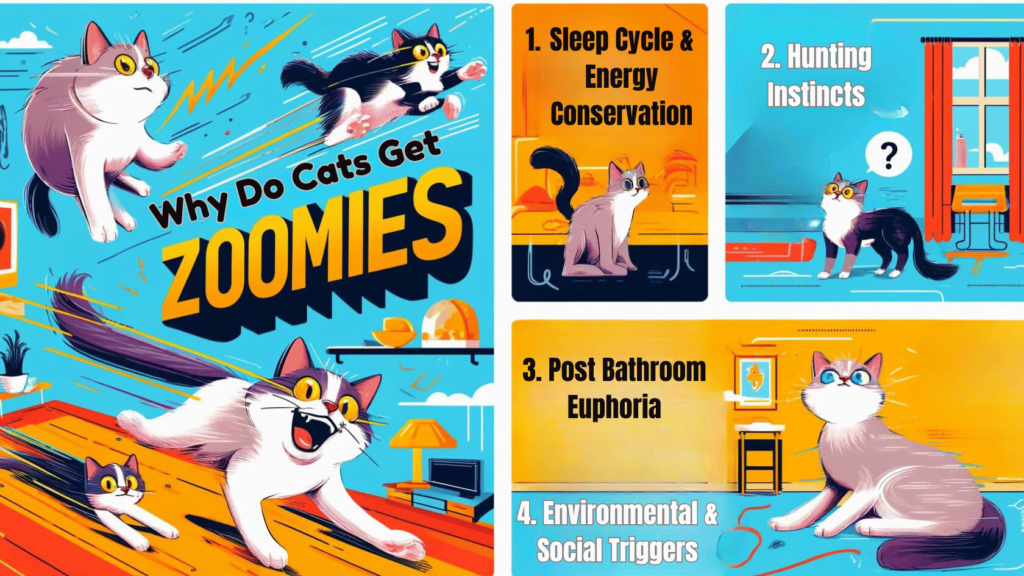
1. Sleep Cycle and Energy Conservation
Cats are crepuscular creatures, meaning their natural activity peaks occur during the twilight hours of dawn and dusk. This sleep-wake rhythm is hardwired into their physiology, inherited from their ancestors who hunted during these times for efficiency and safety.
Domestic cats conserve energy through long periods of rest, and then, when their internal clocks strike ‘active time,’ they release this energy in the form of zoomies. This pattern ensures they’re ready to pounce at a moment’s notice, a trait critical for a predator.
2. Hunting Instincts
Despite the cozy lives they lead as domestic pets, cats retain the sharp instincts of their wild ancestors. Zoomies can be an expression of these primal instincts—dashing around helps keep their hunting skills honed.
When your cat suddenly sprints from one room to another, chasing an imaginary or invisible prey, or even a toy you’ve tossed, they are practicing these essential survival skills.
3. Post-Bathroom Euphoria
It’s not uncommon for cat owners to witness what can only be described as a “victory lap” after their furry friend uses the litter box. Most times, these zoomies are a natural expression of relief or lightness your cat feels after elimination. Just like some people might feel a bit peppier after shedding some “baggage,” so too do our feline friends.
However, it’s not all about feeling free and easy; sometimes, these sprints can stem from discomfort. If your cat’s post-bathroom zoomies come with a side of erratic behavior, it might be time to play detective.
Important: To help keep those zoomies purely playful, maintaining a clean litter box is crucial. An unclean litter box can exacerbate stress and encourage infections, especially in the delicate urinary tracts of our cat companions.
4. Environmental and Social Triggers
Cat zoomies can often seem like spontaneous bursts of energy, but they’re usually triggered by specific changes and stimuli in their environment. Understanding these triggers can help you anticipate and manage these high-speed dashes:
- Sudden Noises: Unexpected sounds such as a doorbell, thunder, or dropping utensils can send your cat racing in excitement or anxiety.
- Visual Triggers: Seeing other animals like birds or squirrels outside the window, or even another cat, can initiate a zoomie. These sights stir up their predatory instincts or territorial responses.
- Changes in the Household: Moving furniture, new decorations, or any alteration to their familiar environment can confuse or excite your cat, resulting in a zoomie.
- Social Dynamics: In homes with more than one cat, zoomies can be contagious. One cat’s burst of energy can spark another, turning what might start as a solo sprint into a full-blown chase session.
Important: Researchers studying animal behavior suggest that zoomies are not just random; they could be linked to the release of accumulated neurotransmitters in the brain, similar to how humans might feel a rush after a sprint or intense exercise.
Youthful Vigor: Understanding Why Young Cats Have More Zoomies
It’s not just your imagination; younger cats and kittens do indeed have more zoomies than their elder feline counterparts. This is because kittens are in a crucial phase of physical and neurological development. The high-speed chases and playful dashes help them:
- Develop Coordination: Navigating through your home at high speeds helps improve their motor skills and body control.
- Increase Physical Strength: Regular bursts of activity build muscle tone and stamina.
- Learn Spatial Awareness: Zoomies involve a lot of dodging and weaving, which is excellent practice for understanding and maneuvering in their environment.
Are Zoomies Good for Cats?
Zoomies serve several beneficial purposes for your cat’s health and well-being:
- Physical Health: These spontaneous sprints help maintain your cat’s muscular tone and agility. Running, jumping, and dodging furniture keeps their body in shape and can prevent obesity, a common problem in indoor cats.
- Mental Stimulation: Zoomies also help keep your cat’s mind sharp. The unexpected dashes are often a sign of a healthy playful spirit, especially in an environment that may otherwise be too static.
When to Worry about Zoomies
While zoomies are a typical and endearing aspect of feline behavior, certain signs during these episodes might point to underlying health issues that need attention. It’s crucial for cat owners to recognize when zoomies might be a signal of something more serious.
Here are the key indicators that your cat’s zoomies might be a sign of underlying health issues:
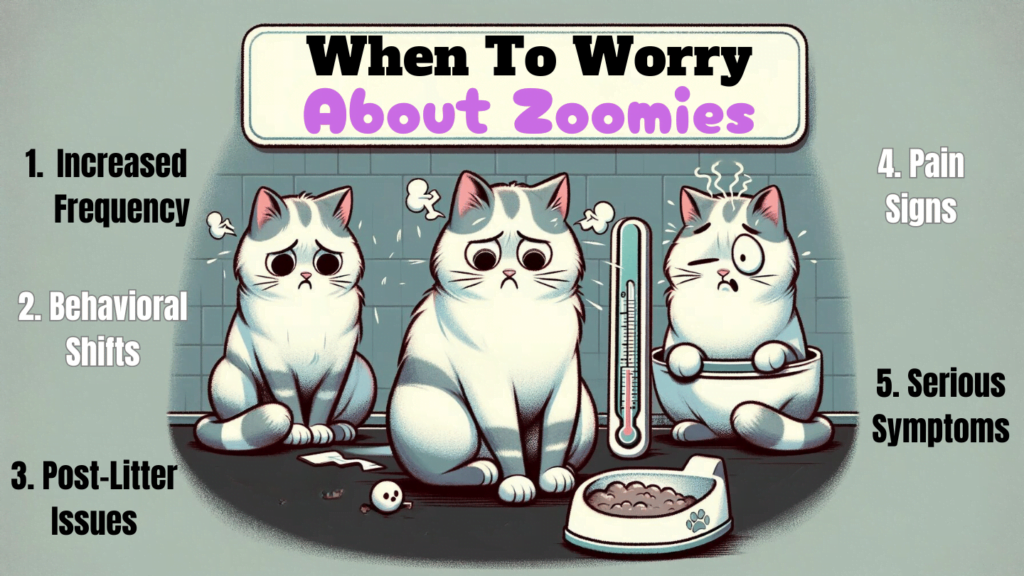
- Excessive Frequency or Intensity: If your cat’s zoomies become more frequent or intense, it could signal stress or anxiety. This is especially concerning if such behavior seems out of character or comes with other distress signs.
- Changes Accompanying Zoomies: Significant weight changes, alterations in vocalization, or shifts in eating and litter box habits can all signal health problems. These changes might indicate anything from minor dietary discomforts to serious medical conditions.
- Discomfort Signs: Zoomies that occur right after using the litter box can suggest discomfort from urinary tract infections or constipation. Additionally, avoidance of the litter box or noticeable changes in stool appearance can also indicate health issues.
- Physical Pain Indicators: Be alert for signs of discomfort like limping, reluctance to jump, which might suggest your cat is in pain. Accompanying behavioral changes such as increased aggression or altered sleep patterns can further signify physical distress.
- Unusual Symptoms Accompanying Zoomies: If your cat shows symptoms such as vomiting, diarrhea, excessive panting, or drooling during or immediately after a zoomie session, it’s crucial to consult your vet immediately.
Preventative Measures: To help prevent these issues, regular vet visits are essential for catching health problems before they become serious
Effective Strategies to Manage Your Cat’s Zoomies
Managing your cat’s zoomies effectively is essential for keeping these bursts of energy fun and safe. Here are comprehensive strategies to help channel their enthusiasm in a healthy way, incorporating modern cat gadgets, environmental tweaks, and behavior management techniques.
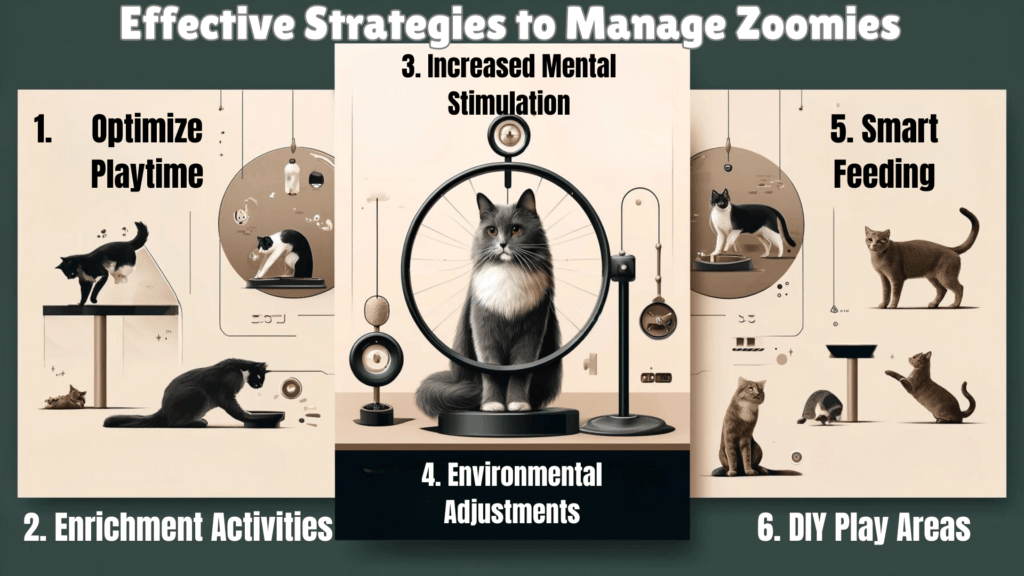
1. Optimize Playtime Scheduling
Consistently aligning playtime with your cat’s natural activity peaks can significantly prevent unexpected nocturnal zoomies. By scheduling play sessions during early morning or late evening, you align these activities with their highest energy levels, ensuring a peaceful night’s rest for both of you.
2. Enhance With Enrichment Activities
Interactive toys that mimic prey movements provide crucial mental and physical engagement. Consider using laser pointers, motorized mice, or puzzle feeders to stimulate your cat’s predatory instincts without causing frustration. Unlike static toys or videos that can’t be ‘caught’, these gadgets allow a satisfactory ‘kill’, releasing those happy hormones crucial for mental health.
Pro Tip: Incorporating a cat exercise wheel provides your cat with a safe and controlled environment to burn off energy by running, which is a natural activity for them.
3. Increase Mental Stimulation
Teach your cat new commands or tricks to mentally engage them and use up their energy. This not only helps manage their zoomies but also strengthens your bond with them. Regular mental challenges keep their environment stimulating and prevent boredom, a common trigger for erratic behavior.
4. Make Environmental Adjustments
Creating a safe play environment at home is key. Secure any loose items that could be knocked over during a zoomie session, and consider blocking off lower parts of windows to prevent your cat from seeing other cats outside, which can trigger territorial stress. Additionally, providing hiding spots like cardboard boxes or empty shelves can help your cat feel secure and reduce anxiety.
5. Implement Smart Feeding Techniques
Consider optimizing their feeding schedule by dividing their diet into multiple small meals throughout the day. This approach helps to maintain stable energy levels, reducing the likelihood of sudden bursts of hyperactivity.
Smart feeders are an excellent tool for ensuring your cat gets consistent, portion-controlled meals even when you’re not around. These devices can be programmed to dispense food at regular intervals, mimicking the natural feeding patterns of cats and keeping their energy levels even throughout the day.
6. Create Structured Play Areas
Consider building a DIY agility course or designated play area where your cat can safely unleash their energy. This area should include various structures for climbing, jumping, and hiding, which not only helps in expending energy but also keeps them engaged.
Wrapping Up: Understanding Cat Zoomies
Zoomies are more than just a funny quirk; they are a manifestation of your cat’s natural instincts and physical vigor. By understanding what triggers these bursts of energy, you can better appreciate this aspect of your pet’s personality and ensure that they remain a healthy and joyful expression of their liveliness.
See your cat’s zoomies as a sign of health and happiness. It’s a behavior that offers insight into your cat’s well-being and mood.
Meet Sean, a fintech whiz with a penchant for pet purrs and blockchain buzz. After a decade of fintech feats, Sean’s tech talents leaped from ledger lines to litter lines, driven by a passion for pets and a vision for a more connected pet care community. With three critter companions as co-pilots, Sean launched this blog to share a treasury of pet-friendly tech tips and tales.

